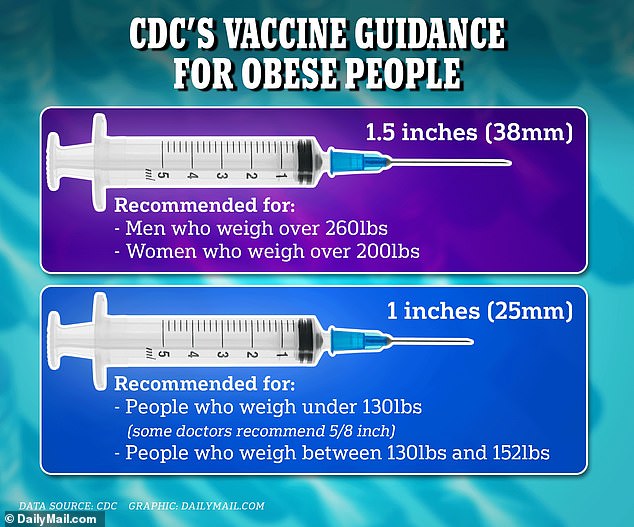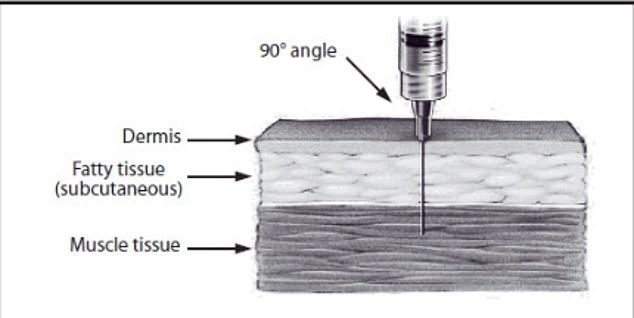CDC says obese people should be vaccinated with longer NEEDLES to pierce through layers of fat – amid flu and Covid booster rollouts
Americans of all shapes and sizes are heading to pharmacies and doctor’s offices for flu and Covid shots this fall, but they may not know that size matters when it comes to the needle going into their arms.
Center for Disease Control and Prevention guidance determines that men and women up to about 150 pounds should be given a one-inch needle.
But for adults over 200 pounds, a longer needle of about an inch and a half will be needed to penetrate fat and deep muscle tissue.
Fat people are already disproportionately more likely to get sick from Covid, compounding the problem.

The majority of people with no experience in medical care may not realize that needle length matters, which means very few people know how to even discuss this with their doctor or pharmacist.

The injection needle used must penetrate fatty or adipose tissue to reach the muscles where the contents of the injection, that is, the Covid vaccine, are deposited
Dr. William Schaffner, an infectious disease expert at Vanderbilt University, told DailyMail.com: ‘Doctors don’t want to risk the vaccine not being an immunization in their patients when they grow up. Therefore, use a larger needle for intramuscular vaccinations.’
Recommending that vaccine administrators take a person’s weight into account when choosing which needle length to use is not new. Healthcare professionals learn it in school and on the job.
The CDC has said for years that a decision on needle length “should be made for each person based on the size of the muscle, the thickness of the fatty tissue at the injection site… and the depth below the muscle surface where the material is lodged.” . needs to be injected.’
However, this guideline is not widely applied in practice.
Dr. Schaffner said, “I don’t think the average person would have thought about that at all. Once they do that and think about it for five seconds, they won’t be that surprised.
‘It shouldn’t depend on the patient to bring that up. However, cooperation is always good and if a patient is aware of this, it is good to bring it up in a friendly and helpful manner.’
Some studies estimate that doctors who vaccinate overweight and obese people get the needle length wrong as much as 75 percent of the time.
Using a needle slightly longer than the standard 1 inch length for an overweight person gives the drug a better chance of entering the fatty tissue and depositing it in the muscles, which is the whole point of a vaccine is.
According to the CDC, “The appropriate needle length depends on age and body weight. Injection technique is the most important parameter to ensure efficient intramuscular administration of the vaccine.
‘For all intramuscular injections, the needle should be long enough to reach the muscle mass and prevent the vaccine from seeping into subcutaneous tissue, but not so long as to involve underlying nerves, blood vessels or bone.’
Although needle length is important, the majority of people with no experience in medical care may not realize this. That means very few people lining up for a booster with their sleeves rolled up are likely to even bring it up to their doctor or pharmacist.
Population studies have consistently shown that professionals administering injections reach for the wrong size needle. In 1997, a study showed that the standard needles were one inch failed to penetrate the deltoid muscles in 17 percent of men’s arms and 48 percent of women’s arms.
A 2013 study in the journal Applied nursing research found that among all patients of all weights surveyed, only 50 percent of injections were administered correctly. And in overweight and obese patients, that error rate reached as high as 75 percent.
Using the wrong size needle can reduce the effectiveness of the vaccine, although the evidence on this is mixed.
A 2010 study published in the journal Pediatrics tried to determine how body mass index and needle length affect the effectiveness of the hepatitis B vaccine, which, like Covid and flu shots, is intended to be administered deep into the muscles.
Obese adolescents who received the vaccine through a 4.5 cm needle had a significantly higher antibody response than those who received the injection through a 2.5 cm needle.
Meanwhile, a study published in the May 2023 issue shows Naturopathy argued that needle length did not change the efficacy of the Covid vaccine.
Researchers found that the maximum antibody response was actually higher in obese people who received the injection with a needle of the same length as non-obese people, although their immunity tended to wane more quickly.
Obese people with a body mass index of 30 or higher should still get vaccinated against Covid and flu. Obesity significantly increases the risk of getting a severe case of Covid and has been shown to triple the risk of hospital admission.
The CDC reported in the spring of 2021, around the first anniversary of the outbreak that started it all, that about 78 percent of all people who were hospitalized, required a ventilator or died from Covid were overweight or obese.
And a 2021 study conducted by researchers from Tufts University in Massachusetts found that 89 percent of Covid hospitalizations as of November 2020 could be attributed to one of four chronic conditions, including obesity – which was blamed for 30 percent of cases, the largest share – as well as high blood pressure, diabetes and heart – and vascular diseases. failure.
